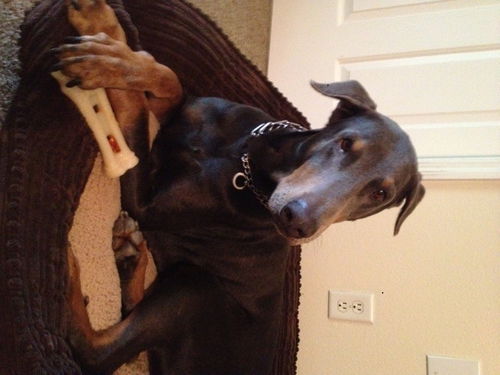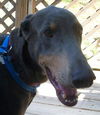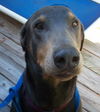
| My Rescue |
| Login to Remember your Favorite Animals and Breeds! |
Bobby Blue is a beautiful boy and eager to please. He is very intelligent and we are working with him on basic manners. He is housetrained, sleeps through the night in his crate and loves nylabones. His coat has sparse areas but I'm sure it will be beautiful in no time. He would be a wonderful obedience dog! His ears and tail were cropped but his ears were not trained up so they are floppy. He tends to keep them pinned back most of the time.
- Leash Manners - Walks well on leash, but is very strong and can pull at times. He will try to slip out of his collar.
- Crate/House Training - 100% housetrained and is crate trained (needs an x-large crate).
- Socialization - Good with people and most dogs. He did fine when he was introduced to cats. He is fine with our 10lb dog and gets along with our other three dogs but is unsure of our large male at times. Possibly because he played too rough with him. He d id well with many people at a rescue event. He is not a fan of kids on bicycles and I don't know that I would recommend him with children under 12.
- Energy Level and Exercise - Moderate energy level, as he does get winded easily. He's s till putting on weight.
- Daily Structure and Schedule - He eats dry food twice a day.
- Confidence Level - Mostly confident but seeks approval often.
- Obedience Training - We have him sit before everything. He also knows down, come, crate and we are working on other commands. He learns very easily and would make a great obedience or agility dog.
- Behaviors - Happy, loving, and wants to be with his people. He can get nervous with people bending/leaning over him.
- Personality Quirks - He is SO smart. He wants to be petted constantly and will nudge if you are not paying attention. He also likes to lean (velcro) on people.
- Ideal Home - He definitely would do best with a yard and lots of attention! I would recommend older children only as he is very strong.
Like many dogs in the South, Bobby is heartworm positive, but don't let that stop you from adopting a great dog. We are treating him with monthly heartworm preventative, our preferred method. Many heartworm positive dogs go on to lead long and healthy lives.
PRBJ treats ALL of our dogs with monthly Heartworm preventative. HW+ dogs are treated with the recommended slow method, using monthly HW preventative as it is gentler on the animal’s system than the more invasive, injection method. Most dogs that are Heartworm positive can lead healthy, normal lives if the disease is caught early and treatment began. There are different options to treat HW and new owners may choose to redirect their type of treatment with direction of their vet. All HW+ dogs have a HW slow treatment info sheet in their adoption folder which will be provided to new owners.
How much do you know about Dobermans? According to www.dogbreedinfo.com, this is a breed of relatively recent origin. It was developed in Germany in the 1860's, presumably by crossing among German Pinschers with Rottweilers, Beauceron, Pinschers, Greyhounds and English Greyhound to create the sleek and highly intelligent Doberman Pinscher. The creator of this mixture was a German tax collector named Louis Dobermann. Dobermann had to travel frequently through bandit-infested areas, and decided to "construct" a watchdog and bodyguard capable of handling any situation that might arise. Bearing the name of its originator (shortened by one n), the Doberman was first presented at a dog show in 1876. It was immediately a big success. Although the Doberman has the reputation of being a very aggressive dog, this is just not the case. For example, Dobes make great therapy dogs. They are sweet and gentle with nursing-home patients - tippy-toeing over IV tubing and walking at the resident's speed (which can be very slow), while at the same time will fiercely defend his master if it becomes necessary. These dogs are like big, protective babies. Doberman Pinschers have many talents including tracking, watchdogging, guarding, police work, military work, search & rescue, therapy work, competitive obedience and schutzhund. The Doberman Pinscher is intense and energetic with tremendous strength and stamina. Versatile, highly intelligent and very easy to train. Determined, fearless and assertive, but not vicious. Noble, loyal and affectionate with the family, it likes to be physically close to the family members. Devoted and watchful, this is a very people oriented breed. The Doberman needs an owner who is willing and able to discipline the dog without being afraid of him. All family members should learn to handle the dog properly, as Dobermans can be pushy if allowed to have their own way too much. The Doberman has been bred to work with man, and he needs this interaction often. They must be with family, and not abandoned to the backyard. They have a life expectancy of around 13 years.
Other Pictures of Bobby Blue the Velcro Dobie (click to see larger version):
 175.7k |
 153.4k |
 59k |
Copyright © Pet Rescue by Judy





